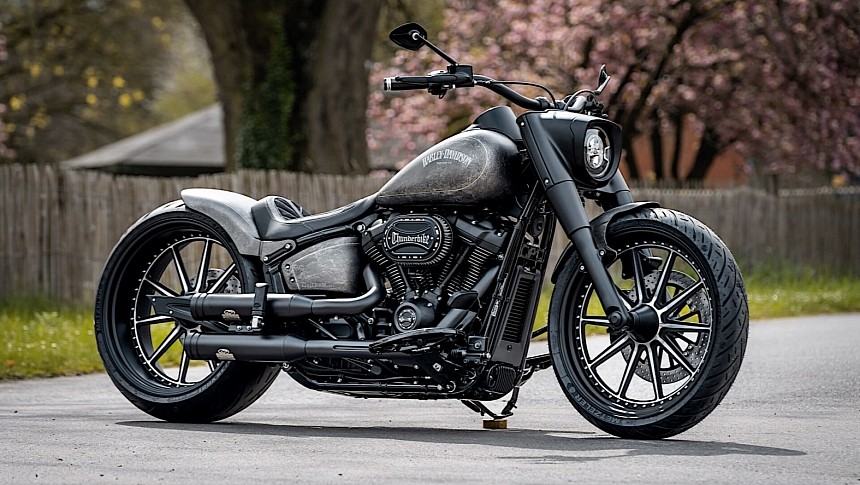Stone washing is a term used in the clothing industry to describe one of the processes used there. More specifically, we're talking about using actual stones, on purpose, in the washing process of fabrics, as a means to get a softer material at the end. Alternatively, stones can also be used on knife blades to give them a rugged, scratched look.
Both of the above are very specific processes, one could say, and not something that could easily inspire the name of a custom motorcycle.
Yet here it is, the Harley-Davidson Stonewash in all its glory. A bike named so not because some kind of stones were used in the process of making it, but because the painting process was conducted in such a way as to make the bike appear not unlike some rugged blade of a knife.
The project is the work of a German custom garage called Thunderbike, and it was originally a Fat Boy 114. The paint job that gives the custom ride its name has been designed and executed by Thunderbike's usual partner in this department, Ingo Kruse.
Since not many colors are suitable for the stone wash effect, gray was chosen for the main body parts of the bike, and carefully treated for the desired effect, and black everywhere else, giving the custom Fat Boy a very cold overall look.
But, as usual with Thunderbike, changes made to the stock motorcycle run far deeper than the paint job. In all, close to 30 custom parts have been used for the Stonewash, which are worth a combined $13,000.
Among the most expensive, and also very obvious changes, are the wheels. Made in-house by Thunderbike, they are beautifully sculpted ten-spoke pieces, with the one at the front sized 21 inches, and the one at the rear of undisclosed diameter, but with a width of 260 mm. Above both of them custom fenders were installed.
The Stonewash rides on an air ride suspension, and uses a custom swingarm at the rear. The braking hardware has been modified as well, but the engine remains the stock 114 supplied by Harley. An aftermarket exhaust system made by Dr. Jekill & Mr. Hyde (which, by the way, is not included in the estimated cost listed above) handles the breathing part.
A wealth of smaller custom elements, yet no less important in the grand scheme of the build, are featured throughout, in the form of covers for various bits of the bike, the handlebar, and even the license plate holders.
The Stonewash is one of the most recent Thunderbike builds, and you can also admire its new shape in the video below. We have no info on who was it made for and the total cost of the build, including man-hours, the exhaust system, and even the paint job that gives the bike its name.
Yet here it is, the Harley-Davidson Stonewash in all its glory. A bike named so not because some kind of stones were used in the process of making it, but because the painting process was conducted in such a way as to make the bike appear not unlike some rugged blade of a knife.
The project is the work of a German custom garage called Thunderbike, and it was originally a Fat Boy 114. The paint job that gives the custom ride its name has been designed and executed by Thunderbike's usual partner in this department, Ingo Kruse.
Since not many colors are suitable for the stone wash effect, gray was chosen for the main body parts of the bike, and carefully treated for the desired effect, and black everywhere else, giving the custom Fat Boy a very cold overall look.
But, as usual with Thunderbike, changes made to the stock motorcycle run far deeper than the paint job. In all, close to 30 custom parts have been used for the Stonewash, which are worth a combined $13,000.
Among the most expensive, and also very obvious changes, are the wheels. Made in-house by Thunderbike, they are beautifully sculpted ten-spoke pieces, with the one at the front sized 21 inches, and the one at the rear of undisclosed diameter, but with a width of 260 mm. Above both of them custom fenders were installed.
The Stonewash rides on an air ride suspension, and uses a custom swingarm at the rear. The braking hardware has been modified as well, but the engine remains the stock 114 supplied by Harley. An aftermarket exhaust system made by Dr. Jekill & Mr. Hyde (which, by the way, is not included in the estimated cost listed above) handles the breathing part.
A wealth of smaller custom elements, yet no less important in the grand scheme of the build, are featured throughout, in the form of covers for various bits of the bike, the handlebar, and even the license plate holders.
The Stonewash is one of the most recent Thunderbike builds, and you can also admire its new shape in the video below. We have no info on who was it made for and the total cost of the build, including man-hours, the exhaust system, and even the paint job that gives the bike its name.




























